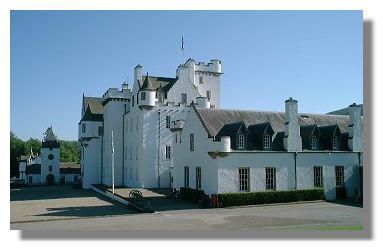
Introduction
Blair Castle is eight miles north of Pitlochry in the very heart of Perthshire and Scotland. The main A9 road from Perth to Inverness passes close by, as it heads north to Glen Garry and the Grampian mountains.
In 2002, Blair Castle was awarded the VisitScotland 5-Star (highest) grading as a tourist attraction. For this is not just a castle trading on its history. It was one of the first private houses in Scotland to open its doors to the public and now welcomes more vistors than any other - attracted by first class facilities, an elegant, historic castle, a large garden, woodland walks amongst tall conifers and a ruined church which is the last resting place of "Bonnie Dundee", John Graham of Claverhouse.
History
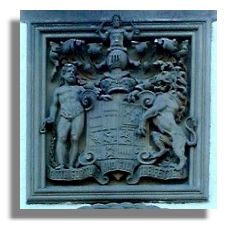 The original Earldom of Atholl died out in the 1300s and King James II gave the title and estate to his half brother, Sir John Stewart of Balvenie, in 1457. The 1st Earl was given the task of subduing the ever troublesome MacDonalds of the Isles which he accomplished (at least temporarily). King James had instructed the Earl to "Furth fortune and fill the fetters" which, roughly translated, meant "Get the chains on him and the future's yours." That is still the family motto!
The original Earldom of Atholl died out in the 1300s and King James II gave the title and estate to his half brother, Sir John Stewart of Balvenie, in 1457. The 1st Earl was given the task of subduing the ever troublesome MacDonalds of the Isles which he accomplished (at least temporarily). King James had instructed the Earl to "Furth fortune and fill the fetters" which, roughly translated, meant "Get the chains on him and the future's yours." That is still the family motto!
The direct Stewart succession was broken at the end of the 16th century when the 5th Earl died without sons and the title passed through a daughter who married Sir William Murray of Tullibardine. Their son became the 1st Murray Earl of Atholl and the title has remained in that family ever since.
The Earl remained loyal to the crown during the Civil War in the middle of the 17th century. The castle was occupied by Cromwell's forces but after the Restoration of King Charles II the 2nd Earl was made a marquis in 1676. Support of Queen Anne by the 2nd Marquis earned a dukedom in 1703. Even so, the new Duke of Atholl refused to support the terms of the Act of Union and at one stage was under house arrest at the castle.
During the Jacobite Uprisings of 1715 and 1745 there were divided loyalties, with some members of the family on each side. At one point, Lord George Murray who commanded the Jacobite campaign in 1745/46 was in the unusual position of besieging his former home of Blair Castle.
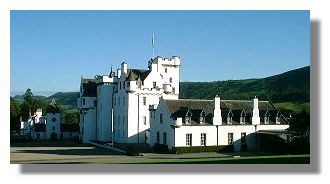 The castle had grown over the centuries but James, 2nd Duke of Atholl remodeled it in the style of a grand Georgian mansion after the 1745 Uprising.
The castle had grown over the centuries but James, 2nd Duke of Atholl remodeled it in the style of a grand Georgian mansion after the 1745 Uprising.
In the 19th century the 4th Duke planted 25 million larch trees with a view to supplying the British navy with wood for their ships. Unfortunately, iron ships overtook the plan!
In 1844, the 6th Duke lent Queen Victoria his castle for a three-week holiday. This was long before she had her own castle built at Balmoral. In appreciation of the way in which the men of Atholl men had looked after her, the Queen granted the Duke and his men the right to bear arms. The Atholl Highlanders are now the only private army in Europe.
Blair Castle Today
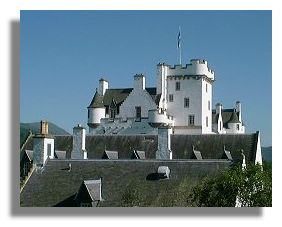 In 1269, when the then Earl of Atholl was away on the Crusades, he returned to find that a neighbour had built a tower on his land. Cumming's Tower (the tower is seen in the picture on the right) is now the oldest part of the castle.
In 1269, when the then Earl of Atholl was away on the Crusades, he returned to find that a neighbour had built a tower on his land. Cumming's Tower (the tower is seen in the picture on the right) is now the oldest part of the castle.
Over the centuries, the castle has grown and has been "modernised" frequently during that time. Today, it is a grand family home and although it was converted into a Georgian Mansion at one stage, the 7th Duke converted it back to a castle - with a crenellated tower and "pepper pots" projecting at appropriate corners.
Of course, the family has accumulated a wealth of paintings, furniture, weaponry to cover the walls, display cabinets packed with fine china and ornaments, books, statues and statuettes, four-poster beds and memorabilia collected over the centuries. Many of the rooms (about 30 of them) are accessible to visitors. Unfortunately, like most grand private homes, photography is not permitted - though there is a well illustrated book available in the well stocked shop attached to the castle.
Hercules Garden
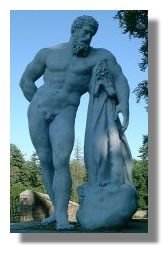 In 1743 James Murray, the 2nd Duke of Atholl placed a statue of Hercules at the top of a long walk to act as a focal point on the landscape. The statue located so that it would be visible from the front door of the castle. Out of sight of the castle, below the statue, is located the walled garden. It was intended to be a spectacular surprise for those walking towards the statue.
In 1743 James Murray, the 2nd Duke of Atholl placed a statue of Hercules at the top of a long walk to act as a focal point on the landscape. The statue located so that it would be visible from the front door of the castle. Out of sight of the castle, below the statue, is located the walled garden. It was intended to be a spectacular surprise for those walking towards the statue.
The Hercules Garden is currently being restored to its former glory. There is an ornamental pond in the centre, surrounded by rows of fruit trees which make a spectacular display in the spring. Around the northern and western sides of the garden are herbaceous borders full of colourful flowers. There were too many to include in this feature but a selection has been set up in a JavaScript Flipbook where the technology turns the pages for you.
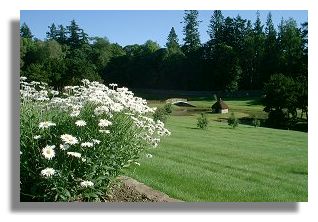
A Walk in the Grounds
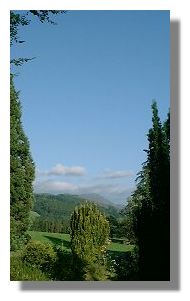 Fortified with a snack from the modern facilities attached to the castle, a walk amongst the tall trees in the grounds of Blair Castle is well worth the effort. There are many very tall Wellingtonia and Douglas firs threaded by winding paths. Every now and again, the trees part and the vista towards the Atholl Hills and Forest can be glimpsed.
Fortified with a snack from the modern facilities attached to the castle, a walk amongst the tall trees in the grounds of Blair Castle is well worth the effort. There are many very tall Wellingtonia and Douglas firs threaded by winding paths. Every now and again, the trees part and the vista towards the Atholl Hills and Forest can be glimpsed.
The grounds stretch over to the old Perth-Inverness road where the original village of Old Blair used to be located until the new bridge over the river Tilt and road was built in 1823. Prior to this, St Bride's Kirk, was the local church and the ruins can still be seen. The Battle of Killiecrankie took place three miles south of Blair Castle in 1689. John Graham of Claverhouse known as "Bonnie Dundee" and his Highland army supporting the recently deposed King James VII, was victorious over government forces led by the veteran General Hugh Mackay of Scourie who had been heading for Blair Castle.
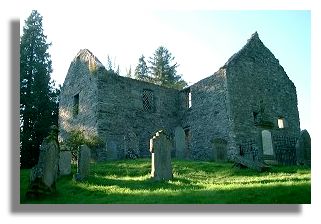 During the battle, the victorious Bonnie Dundee was mortally wounded and his body was brought to St Bride's Kirk. He is buried in a vault beneath the kirk. The burial ground of the Dukes of Atholl lies nearby.
During the battle, the victorious Bonnie Dundee was mortally wounded and his body was brought to St Bride's Kirk. He is buried in a vault beneath the kirk. The burial ground of the Dukes of Atholl lies nearby.



